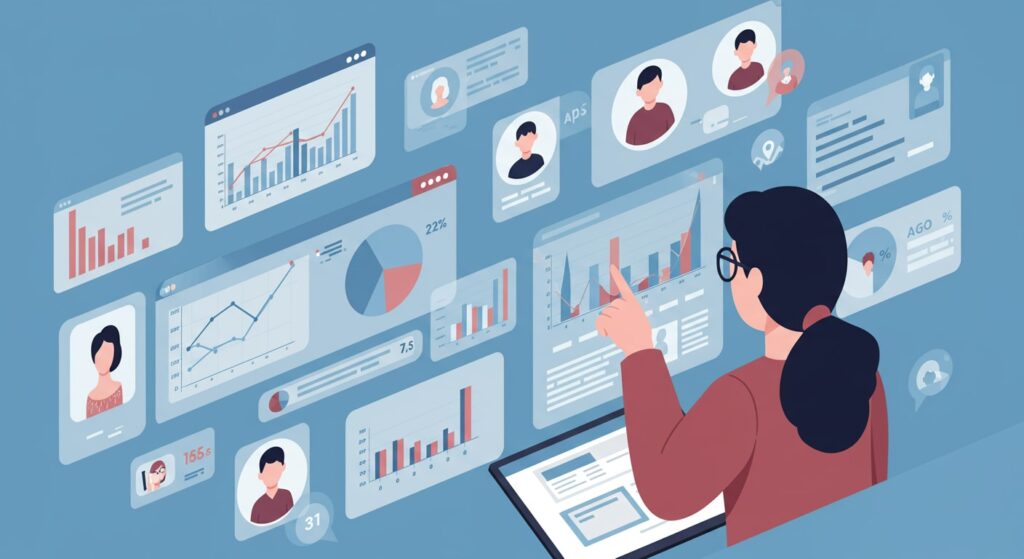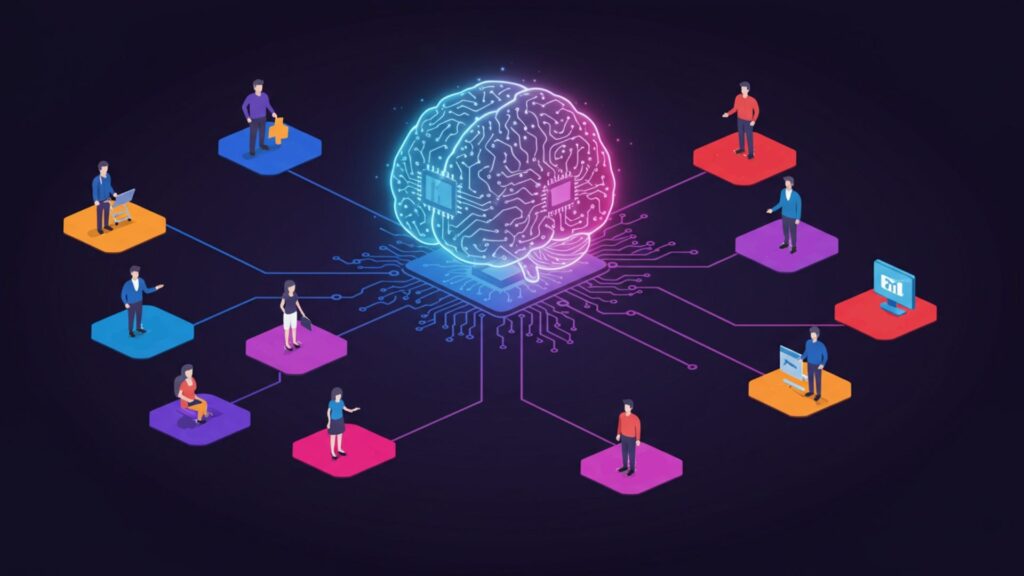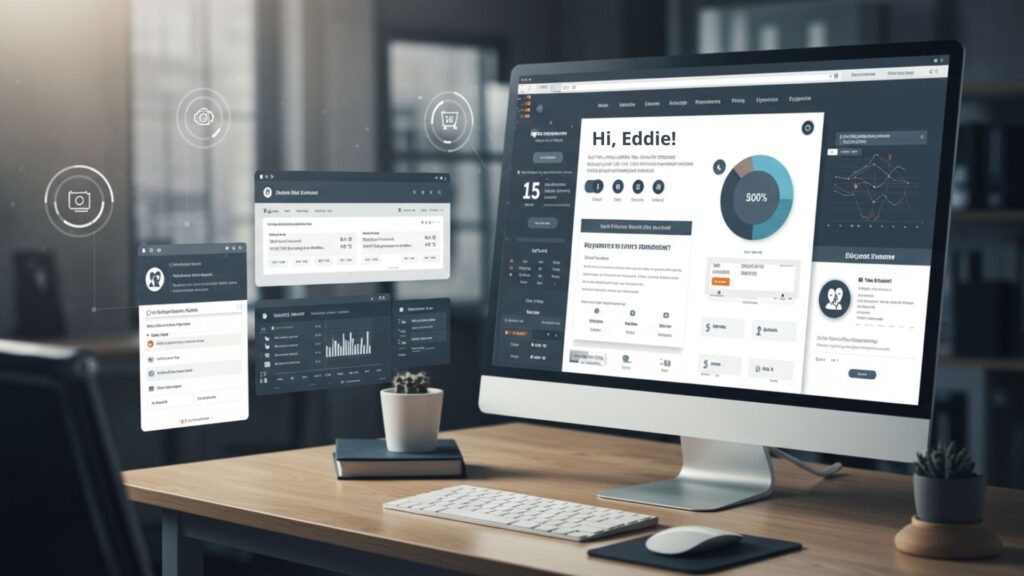Customer expectations are rapidly evolving. Generic, one-size-fits-all website content is no longer enough to capture and keep attention. Instead, audiences demand relevant content that speaks directly to their interests, preferences, and behavior.
Companies that excel at personalization generate 40% more revenue from those activities than average players. The growing demand for curated digital experiences is pushing brands to embrace more sophisticated website personalization strategies that rely on real-time customer data, behavioral data, and audience segments to drive engagement, loyalty, and conversions.
By using smart software, brands can deliver personalized website content based on factors like browsing behavior, location data, and purchase history, transforming static pages into highly dynamic, responsive environments.
From landing pages that shift based on user preferences to personalized recommendations woven into the shopping journey, the benefits of website personalization are vast. Explore how leading brands are leveraging personalization tactics, showcasing website personalization examples, and providing actionable steps to help you create content that drives deeper customer engagement and long-term customer satisfaction.
Why Personalized Website Content Is a Must-Have in Today’s Digital Landscape
Digital consumers expect a personalized experience that mirrors the tailored service of in-person interactions. As online competition intensifies and customer attention spans shrink, delivering static, generic website content simply won’t cut it.
Instead, brands must embrace personalized website content that adapts to each site visitor’s needs, preferences, and behaviors. From product recommendations based on previous purchases to homepage messaging that reflects a user’s browsing history, personalization is now a key differentiator in digital success.
Website personalization is directly linked to stronger outcomes across the funnel. Companies that prioritize personalization efforts often see higher conversion rates, improved customer engagement, and deeper brand loyalty. Research shows that 80% of consumers are more likely to do business with a company if it offers personalized marketing campaigns or relevant content.
With the right personalization capabilities—powered by audience data, behavioral data, and personalization tools—brands can segment their target audience, anticipate needs, and deliver content that enhances the customer journey. The result is a seamless, emotionally resonant, and high-performing personalized customer experience that keeps prospective customers coming back.
Using Customer Data to Power Personalization
To create meaningful digital experiences, you need a deep understanding of who your website visitors are, what they want, and how they behave. Customer data is your most valuable asset. By leveraging everything from demographic data to past behavior, businesses can craft personalized messages and tailored content that drive action and build trust across the customer journey.

Collecting First-Party and Zero-Party Customer Data
Effective website personalization strategies start with high-quality, consent-based data. First-party data, such as browsing behavior, site behavior, and purchase history, is collected directly from users as they interact with your site. It forms the backbone of most content personalization and marketing efforts, allowing you to understand intent and preferences in real time.
Equally important is zero-party data, which users intentionally share with your brand. Think of survey responses, quiz results, or personal preferences selected in a profile. These insights are gold for personalization strategies, as they provide clear signals about a user’s needs without guesswork. For example, a cookware brand might ask users to choose between “beginner” or “expert” skill levels and then tailor landing pages and product suggestions accordingly.
Integrating Data Across Channels
Even the most advanced personalization tools won’t be effective if your audience data is stuck in silos. To consistently deliver personalized content, brands need to unify data from across touchpoints like email, CRM, e-commerce platforms, customer service logs, and mobile apps. Personalization software or customer data platforms (CDPs) link interactions and identities across the ecosystem.
Example: A returning user clicks an email promotion for hiking gear but lands on a generic homepage. Without integrated data, that personalized email loses impact. But with synchronized systems, your site can recognize the click source, dynamically adjust the homepage with relevant products, and even remind the visitor of their previous browsing history. Having cohesion across channels elevates the user experience, strengthens customer loyalty, and increases the likelihood of conversion.
Enhancing the Customer Experience with Content Personalization
Content personalization enables brands to meet consumer expectations by delivering timely, relevant, and engaging digital experiences tailored to each user. When done well, personalized online content improves customer satisfaction and drives long-term brand loyalty by making every interaction feel intentional and valuable.
Real-Time Relevance for Every Visitor
One of the most powerful aspects of web personalization is its ability to respond to behavior in real time. Whether it’s a returning shopper seeing updated recommendations or a first-time visitor receiving a location-specific offer, dynamic content creates a sense of immediacy and relevance that static experiences can’t match.
For example, a travel website might highlight warm-weather destinations to a user browsing from a cold climate, using location data and browsing behavior to inform the experience. The website creates a more engaging moment and signals that the brand is in tune with the visitor’s context.
Mapping Personalized Content to the Customer Journey
Early-stage visitors may need educational resources or inspiration, while returning customers might be looking for upsells or support. Mapping your content to the customer journey ensures you’re creating experiences that look good and convert.
One effective approach is to build audience segments based on user behavior and then assign tailored experiences at each stage. For instance, a SaaS company might offer an interactive product tour to new visitors, a demo request prompt to mid-funnel prospects, and a feature comparison guide for existing leads. By matching personalization tactics to intent, brands can boost relevance at every stage and help users take the next best action with ease.
Audience Segments: Building for the Right People at the Right Time
The foundation of any effective personalization strategy lies in understanding who you’re speaking to. Segmenting your target audience allows you to move beyond broad demographics and craft experiences based on context, intent, and real-time behavior.
Advanced personalization tools, powered by AI and machine learning, take this a step further by continuously analyzing audience data to uncover patterns, predict preferences, and automatically generate personalized content.

With the help of AI, marketers can dynamically adapt messages. These intelligent systems allow for faster, more scalable personalization efforts, eliminating manual segmentation and enabling teams to respond to shifting audience needs.
Segmenting Based on Demographics, Behavior, and Intent
At a basic level, customer segments may be defined by attributes like age, geography, or industry. But the most impactful segmentation strategies leverage behavioral data, purchase history, and real-time user behavior to surface micro-segments with specific needs. AI-driven tools can automatically cluster users based on their digital footprint, revealing high-value opportunities marketers might otherwise miss.
Take an e-commerce example: rather than simply targeting “female shoppers aged 25–34,” a brand might identify a segment of customers who’ve clicked on eco-friendly products, abandoned carts in the last week, and responded to past personalized email campaigns. With content intelligence, marketers can deliver tailored content that speaks directly to the user’s values and purchasing signals, increasing the chance of conversion.
Leveraging Location Data and Past Behavior
Personalization gets even more powerful when it taps into past behavior and location data. By understanding where someone is and what they’ve done before, brands can orchestrate highly contextual experiences that feel effortless to the user.
For example, a restaurant chain can detect a user’s proximity to a store and highlight time-sensitive promotions or nearby menu favorites based on previous purchases. AI excels at processing these data points at scale, allowing brands to continuously adjust personalization tactics without starting from scratch.
Dynamic Content: Automating Personalization at Scale
Rather than relying on static copy or manual updates, dynamic content adapts in real time based on user behavior, audience segments, or specific events in the customer journey. It enables brands to efficiently scale their personalization efforts, delivering a consistent yet customized experience for every site visitor.
With the help of intelligent decision engines, marketers can set up rules and triggers that automatically adjust website content based on real-time inputs. These capabilities enhance the user experience and boost operational efficiency by reducing manual workloads.
What Is Dynamic Content and How Does It Work?
Dynamic content refers to any piece of digital content that changes based on a user’s profile or actions. This can include headlines, hero banners, CTAs, product listings, forms, and entire landing pages. These changes are triggered by variables such as demographic data, past purchases, or user preferences collected through personalization tools.
Let’s say a user has recently browsed athletic shoes on your site. On their next visit, instead of a generic homepage, they’re greeted with new arrivals in that category, messaging that aligns with their interest, and an exclusive discount banner. Website personalization ensures your brand remains relevant and compelling without requiring manual intervention.
Examples of Dynamic Elements on Landing Pages and Product Pages
Dynamic elements can dramatically improve conversion rates by aligning the content to the user’s current intent. On landing pages, this might include pre-filled forms with known information, location-specific contact details, or targeted messaging that reflects the user’s behavior and interests. For e-commerce brands, product pages can feature upsell modules based on previous purchases or personalized sizing suggestions derived from user behavior and purchase history.
A software company might use personalization techniques to show different case studies depending on the visitor’s industry or job role. AI ensures that content is relevant and prioritized, placing the right assets in front of the right decision-makers at the right time.
Benefits of Website Personalization for Business Growth
The benefits of website personalization extend well beyond short-term conversions. The true long-term value is how personalization improves customer satisfaction, deepens brand loyalty, and strengthens the overall customer experience. When users feel understood and valued, they’re more likely to return, engage, and advocate for your brand.
Intelligent website personalization strategies turn casual visitors into high-value customers. Whether it’s through personalized product suggestions, custom content journeys, or dynamically generated personalized messages, these experiences increase time on site, reduce bounce rates, and contribute to stronger retention and revenue growth.

Customer Loyalty Starts with Delivering Personalized Content
Delivering personalized experiences is one of the most effective ways to build and maintain customer loyalty. When a returning user sees content tailored to their preferences or current needs, it creates a sense of recognition that deepens emotional connection. Over time, this strengthens trust and encourages repeat engagement, especially when the experience is consistent across channels and touchpoints.
Personalized loyalty programs, contextual product bundles, and personalized marketing based on previous browsing history or past purchases are just a few personalization examples that foster long-term relationships. Existing customers become brand advocates, fueling organic growth.
By using AI-powered personalization capabilities to learn from and respond to user behavior, businesses can deliver the kind of consistently relevant and valuable experiences that keep customers coming back.
Testing, Optimizing, and Scaling Personalization Efforts
Even the most well-crafted personalization strategies need regular tuning. To ensure your website personalization efforts are delivering maximum impact, conduct ongoing testing and optimization. A/B testing personalized vs. generic content, experimenting with different personalization tactics, and measuring performance across customer segments will help you refine your approach over time.
Scalability also matters. As your audience grows and expectations evolve, your personalization must evolve too. Automation, AI, and modular content empower you to dynamically adapt personalized content without overwhelming your marketing team.
By treating content personalization as an iterative, data-driven process, you can continuously improve the customer experience and drive sustainable growth at scale.
Make Personalized Website Content the Center of Your Digital Strategy
When digital marketing is defined by instant gratification and rising customer expectations, personalized website content is essential. From increasing conversion rates to building lasting customer loyalty, the impact of delivering tailored content that aligns with each visitor can be transformative. Brands that invest in website personalization strategies are setting themselves up for greater agility, stronger engagement, and long-term competitive advantage.
At Aprimo, we understand the power of personalization because we’ve built our platform around it. Our AI-driven content operations and digital asset management capabilities are designed to help marketers scale content personalization across every channel with precision, speed, and control. We help you turn audience data into action with automated workflows and intelligent experiences that let you deliver personalized content at scale. Schedule a demo and see how Aprimo can help you create smarter, more engaging digital experiences every time.


